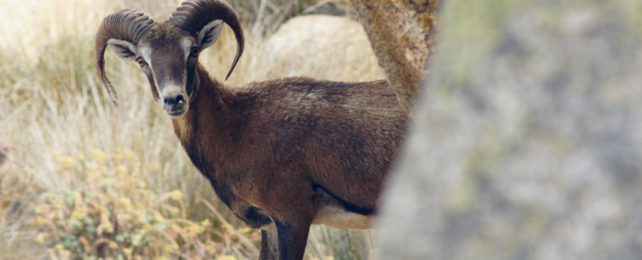Clues within ancient animal poop challenge the current prevailing theory that humans tamed plants before beasts.
Researchers found the preserved dung in question alongside buried remains of ancient hunter-gatherer dwellings in Syria that date back to around 13,000 years ago.
"We were surprised when we realized that hunter-gatherers were bringing live animals to Abu Hureyra between 12,800 and 12,300 years ago and keeping them outside of their hut," the researchers explain in a statement.
"This is almost 2,000 years earlier than what we have seen elsewhere, although it is in line with what we might expect for the Euphrates Valley."
Back in the early 1970s, excavations Abu Hureyra in what's now Syria revealed one of the longest known sequences of humanity's transition from hunter-gatherers to farmers.
This location within the Fertile Crescent was particularly idyllic for humans, with easy access to floodplains, steppe, and woodlands. It was filled with a diverse range of flora and fauna, and its initial human occupation in the Epipalaeolithic period within the Stone Age was thought to consist of less than 200 people.
This site now lies submerged beneath Lake Assad, a region that can be hard to access due to ongoing conflicts. Luckily, past archaeologists carefully stored and cataloged heaps of samples from the site.
It is dung spherulites within these samples that University of Connecticut anthropologist Alexia Smith and colleagues investigated to draw their conclusions. They used new methods to isolate the ancient dung from newer fecal contaminants and quantify them.
"Until recently, it has been hard to find a method that would allow archaeologists to examine the very earliest experiments with animal tending prior to fully-fledged animal domestication and herding," the team says in a statement.
Studies of this region have dated our taming of cereals to as early as 11,500 years ago (calBP), followed by a series of other crops. It wasn't till around 10,000 years ago that there was clear evidence of animal domestication, during a culture designated as Pre-Pottery Neolithic B.
"The general understanding remains that cultivation began first, tethering people to the land, and that herding followed," the team explains in their paper. "The research outlined here raises questions regarding this trajectory."
Smith and colleagues constructed a timeline from the preserved remnants of the repeated and varying activities involving dung.
Some activities like using the poop as fuel left clearer more distinct use signals, as did the use of dung to line floors of dwellings.
They found that the first part of the Epipalaeolithic period (13,300-12,800 calBP) had low isolated spherulites and almost no clusters, suggesting there was not a great deal of interaction between the hunter-gatherers and live animals.
But in line with a dramatic shift in architecture to more durable dwellings during the second part of the Epipalaeolithic period (12,800-12,300 calBP), there was a spike of dung associated with firepits, and another lot of spherulite clusters near a work area right outside the settlers' homes.
The abundance of spherulites and excess dung being burnt suggest that a small number of animals were kept and tended on site. Researchers suspect that using the dung as fuel to supplement wood fires was a convenient way to get rid of the excess dung.
The researchers also suggest the animals possibly served as live meat storage to make up for variability in presence of these hunter-gatherers' main prey – gazelles. This would have further enabled the hunter-gathers to occupy the same site year-round.
These findings also coincide with increasing proportions of wild sheep and aurochs in the faunal records of the area.
"Observations from Abu Hureyra indicate small-scale on-site animal keeping during the Epipalaeolithic between 12,800 and 12,300 calBP by people continuing to live a hunter-gatherer lifestyle," the team writes.
"Tending small numbers of animals immediately outside of dwellings appears to have been a common strategy used by people as part of the early transition from hunting to herding across Southwest Asia and beyond.
"This marks the earliest occurrence of such tending, raising the questions of whether early animal tending occurred before or alongside early cultivation, rather than developing later."
By the Neolithic phase 2A (10,600 calBP) there are clear signs of animal tending, with herding well established, and dung being used in plaster floors, a practice now well spread across Southwest Asia.
"The data presented here mark the transition from early, short-term, on-site animal tending during the Epipalaeolithic 1B phase to full scale, offsite herding during Neolithic 2B," the researchers explain.
The researchers don't have enough evidence to narrow down exactly which animals were being kept beyond them being ruminant herbivores.
While gazelles were plentiful and often mark territory with their dung, defecating repeatedly in the same area, creating dung piles that are easy to collect, males, in particular, can be very aggressive.
An easier alternative would have been wild sheep. Previous studies found sheep bones associated with human settlements early as 10,600 years ago.
"The behaviors of wild sheep, with fixed-membership herds based on a male hierarchy, makes them much more amenable to tending than gazelle, providing a necessary precursor to domestication," Smith and team conclude.
This research was published in PLOS ONE.
